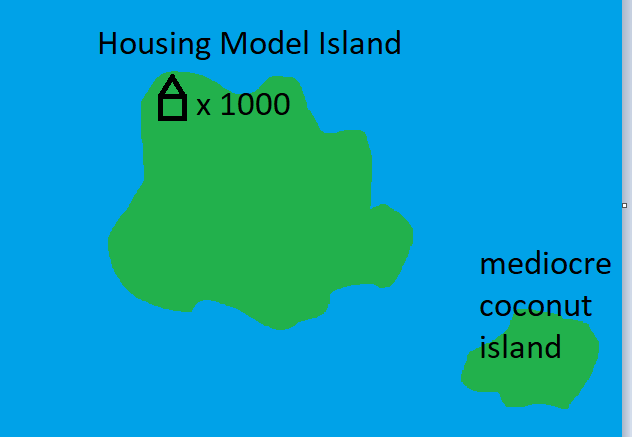There’s quite a bit of vocal disagreement in Chapel Hill about how housing and housing prices work. Here, I lay out a simplistic model to illustrate how I think and what I assume about housing and housing prices. I hope this helps move our conversation forward.
First, I will say that this model is going to be absurd to begin with. Stick with me. It’ll get more realistic in each step.
Let’s assume there is an island. There are 1,000 people on the island. Each person lives in a single house (?). Each house has only one person (?). All the houses are identical to each other.

No entity owns more than a few houses and none of the islanders own a house. Instead they all pay rent. Right now, the rent is 10 sea shells (??????????) per person per house per day.
Now let’s assume that Evil MegaCorp (EMC) builds one new house tomorrow. It is empty. EMC is losing money when it is empty. EMC hates losing money. If EMC offers to rent it at 11 sea shells per day (???????????), no one will rent because it is more expensive than the going rate for an identical house AND moving is a pain in the ass.
If they offer to rent it at 1 sea shell per day (?), everyone will try to move at once to save 9 sea shells per day (?????????). EMC would be losing potential profit. They adjust their price and offer to rent the new house at 9 sea shells per day (?????????).
There might be a few islanders who figure that the hassle of moving is worth saving a sea shell per day (?). Now the other apartments owned by Mom and Pop Limited and Doe LLC will drop their rates by just enough to make sure that the newly vacated apartment is attractively priced to get a new tenant who is willing to pay the hassle costs to move. Soon there is a new, slightly lower price level and one apartment vacant on Housing Market Island. The new price level is about equal to the difference between ten sea shells per day minus the hassle cost of moving.
This is an absurdly simple model. We assume no migration, no household formation and uniform housing products.
Let’s add a wrinkle. Let’s add migration.
People like to live on Housing Market Island. It is an awesome island with amazing coconuts (?). Coconuts are tasty. The island across the lagoon has mediocre coconuts. There are 10,000 people on Mediocre Coconut Island. Someone wants to live near the amazing coconuts so they swim across the lagoon to Housing Model Island and look for a new house.

The new residents to Housing Model Island are excited to be closer to the coconuts. They start collecting shells and soon can pay the market rate for that empty house. Rents increase again as there is no hassle cost of moving. If they have 10 shells per day, they’ll rent that vacant house on Housing Market Island and soon everyone else is now getting charged 10 shells per day again. They wave to their buddy across the lagoon. The buddy swims over the next day and starts collecting sea shells to outbid a current resident for a house. A new offer is made to Mom and Pop Limited for 11 shells per day. Someone is either evicted or makes a counter-offer that they’ll pay 11 shells per day.
The lagoon swimmers figure out that if they swim with the tides, they can readily get across the lagoon with little energy. Soon there are 1500 people trying to swim across the lagoon to go to the Housing Model Island. There are no new houses constructed. Prices go up so that the current house owners collect a whole lot more sea shells. The owners keep on increasing rents until there are only 1,001 renters able to afford the new, much higher daily sea shell rents.
People who are on the Mediocre Coconut Island want to live on the Housing Model Island. A few people get together and figure out that while they aren’t the best shell collectors in the world, that they find more sea shells than the 1,001st best collector by their combined efforts . Sure, their personal space in the house that they can rent might be a bit limited, but they value access to really good coconuts more than they value personal space. Soon the Housing Model Island has a population explosion as hundreds of huts now have two or three people in each hut. The multi-person huts outbid most of the single shell collectors who previously were living in these huts.
Now someone on the Model Housing Island notes that population is going up and daily shell rents are pretty high relative to the Mediocre Coconut Island. They think that they can build new huts to house some of the people who want to move to Model Housing Island. If there are new huts built, some people already on the island will move into the new huts with either no or fewer roommates and people from Mediocre Coconut Island will move in.
This proposal generates a lot of discussion at the nightly town campfire as dueling petitions are entered into the public record.
This is a basic story of how I think about housing markets. People will want to live in desirable locations. Desirable locations will be bid up relative to undesirable locations. People will move if the hassle costs are low relative to changes in rent. People will respond to price levels by changing their consumption of housing by increasing density within each available unit and multi-payer housing units will often outbid single payer housing units. New construction is useful in constraining price increases.
These are the assumptions that I use. Are there problems in this pretty simple toy model? Hell yes, but it is a useful model to give directional guidance.
